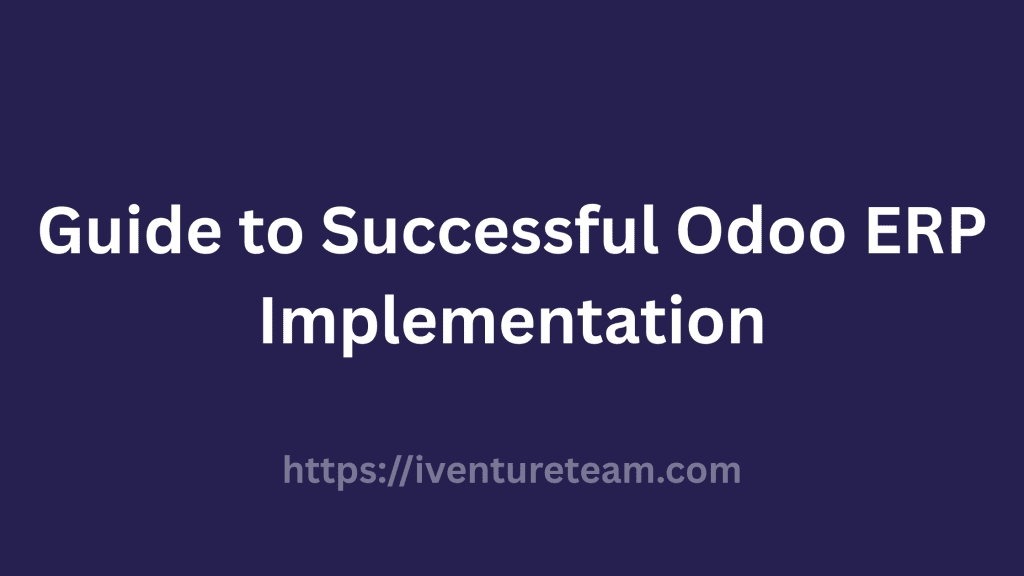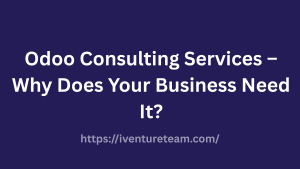Odoo ERP implementation can transform your business, simplify your operation, generate data, and improve customer satisfaction. Today’s rapidly changing commercial landscape has made integrated solutions critical for organizations to handle a wide range of functions, including finance, sales, inventory, and human resources. With its versatile solution and suite of applications designed to cater to various business requirements, Odoo ERP proves to be information-rich and cost-effective. This extensive guide discusses the reasons you should consider investing in Odoo ERP implementation and the step-by-step process to ensure successful deployment.
Table of Content
What is Odoo ERP Implementation?
Odoo ERP implementation means setting up the Odoo suite of applications in your organization to simplify and automate business processes. The process includes multiple phases, which are requirement analysis, system design, customization, data migration, training, and support. Proper implementation aligns the ERP system with the organization’s goals, allowing for the best possible performance and user adoption. Good planning and implementation reduce the disruptions and speed up the move to a more efficient system.
Related Post: List of Best Odoo Implementation Companies
Benefits of Odoo ERP Implementation
There are many benefits of Odoo ERP implementation, and it can drastically improve your business operations. An integrated ERP system, on the other hand, ensures that all the departments work in sync with each other, minimizing everywhere and everything, leading to prominent productivity. Without the need for other software solutions, Odoo simplifies and reduces costs by centralizing critical business functions. In addition to this, it is an extremely flexible solution due to its easy-to-use interface and customizable modules that can fit into companies of all kinds and sizes.
Streamlining Operations
Odoo serves all your business functions on one unified platform, eliminating redundancy and increasing workflow efficiency. Automation of repetitive tasks allows employees to dedicate time to areas that require strategic thinking or higher skills, resulting in improved efficiency. Furthermore, the smooth integration of departments removes obstacles and improves cross-functional collaboration. Businesses can streamline their resource utilization, and time and effort are committed to high-value tasks.
Enhanced Customer Experience
Centralized customer data enables businesses to offer personalized services, address inquiries in real-time, and develop relationships more efficiently. That increases customer satisfaction and customer loyalty. By having a single view of customer interactions, businesses can predict their needs and personalize their services based on the same. Automation capabilities improve order management and post-sales services, resulting in a better customer journey.
Data-Driven Insights
Odoo allows real-time reporting and analytics for data-informed decision-making. Data tells if you are on track with trends, performance, and strategies to grow and leverage against those growing businesses. This will enable business organizations to analyze important performance indicators due to the capability of creating customized reports. Predictive analytics empowers businesses to take advanced business actions that lead to long-term success.
Scalability & Flexibility
The modular nature of Odoo enables businesses to start with apps that fulfill their basic needs and expand their usage as required. The ERP system can accommodate the increased workload. If your company begins expanding into new markets or if you start new product lines, Odoo seamlessly adapts to your changing needs. Its cloud-based infrastructure enables businesses to operate from multiple locations without any problems.
Cost Savings & Efficiency
By having multiple business applications in a single system, Odoo eliminates the need for multiple software, thus reducing cost. It is also possible to achieve greater efficiency by improving processes and better managing resources. Automation reduces the risk of human error, which can lead to operational risks and delays. In addition to saving time for everyone involved, more streamlined workflows also reduce operational costs because they cut down on duplicate tasks, improving the efficiency of the workforce.
Compliance & Risk Management
Odoo helps organizations stay aligned with industry regulations and standards by providing features like audit trails, standardized reporting, and automated compliance checks. This also includes helping manage and reduce risk through end-to-end governance of operations. It guarantees that financial statements will be transparent and more convenient for regulatory audits. Its security features keep workstation-sensitive business data safe from both cybersecurity attacks and unauthorized access.
Collaboration & Communication
It allows for integration between departments through unified communication and shared data access. It allows teams to collaborate more efficiently, which results in improved synchronization and project delivery. This system allows one to share information in real time and keeps all team members in sync with business objectives. Teamwork and accountability are further simplified through centralized documentation and task management features.
Steps to Implement Odoo ERP Successfully
An Odoo ERP implementation requires a planned approach. Now let’s move on to the next steps that guide the right deployment of the system. An ERP system implementation is a complex venture that touches and transforms everything from your operations to your customer interactions. When these approaches are well-planned, the smoothness of the transition reduces costs and the level of disruption while ensuring greater efficiency. A successful Odoo ERP implementation involves several key steps, and they are as follows.
Define Your Business Goals
To start off, list the goals that you want to achieve out of the Odoo ERP implementation. Determine specific points and areas for improvement to help guarantee the system supports your strategic vision. Define measurable KPIs to track successful implementation. Share these goals across cross-functional teams for alignment and collaborative action.
Select the Best Odoo Implementation Partner
Selecting the right implementation partner is critical. Choose a team that has years of experience and understands Odoo inside and out to create solutions for you. Make sure that they provide post-implementation support and training to facilitate a smooth transition. Check client testimonials and case studies to ensure their expertise and reliability.
Conduct a Thorough Analysis
Carry out a comprehensive evaluation of your existing processes, systems, and data. This analysis will allow users to find the gaps to be filled, redundancies to be eliminated, and opportunities to optimize, which can set the basis for the design of the system. Involve cross-department stakeholders to understand the business needs end-to-end. Establish key workstreams to see how the new system fits into current workflows.
Customize & Configure
Customize Odoo’s modules according to your requirements. This could be anything from configuring their existing capability to developing custom modules to cater to specific business processes. Focus on user-friendliness and effectiveness of the system to reduce friction during the adoption process. Iteratively test to ensure all configurations meet business objectives.
Test & Validate
Extensive testing must be implemented before large-scale deployment to confirm that the system works as expected. These include unit testing, integration testing, and user acceptance testing to catch any problems. Test with end-users and obtain real-world feedback for system usability. Check the accuracy of the data and validate the process before going on to the next step.
Train Your Team
Successful adoption requires comprehensive training. Provide users with the knowledge and skills to use the system, clear doubts, and show how the early continual usage of the new system will improve their processes and outcomes. They need user guides, training videos, and live workshops to assist them in their learning. Train them on the system in a test environment to get them familiar with it and gain confidence in using it.
Test Run & Improve
Implement the system in a controlled environment or with a specific department to observe its performance. Collect feedback, track usage, and iterate on the product to enhance functionality and user experience. Adopt the solution with some finesse by addressing user concerns. Monitor performance metrics to discover areas for additional improvement.
Data Migration
Planned and executed the migration of data from older systems to Odoo. You would also make sure you have the data’s integrity, accuracy, and completeness to ensure that operations continue throughout this process. Perform data cleansing to eliminate duplicates and provide records prior to migration. Data Migration will re-check the test data post-migration
Go Live
After completing testing and training, transition to a full-scale implementation. This will be a high-risk time, so monitor the system to sort out any issues quickly and maintain a provoked transition. Create a first-line defense support system to help with initial troubleshooting. Then, take feedback from workers to make processes even better and ensure user satisfaction.
Continuous Improvement
After rolling them out, evaluate the system’s performance and look for ways to improve. Regular updates and user feedback, along with performance metrics, can help shape ongoing improvements for individual systems to offer as much value as possible. Plan corresponding periodic reviews to ensure ERP evolves accordingly. Use the updates and the new features of Odoo to optimize your system.
Why is the iVenture Team the Best Odoo Implementation Partner?
Partner selection is critical for successful Odoo ERP Implementation service. The iVenture Team is one of the best Odoo ERP implementation company for you, as they provide you with Odoo implementation along with other services to suit all the needs of your business.
iVenture Team is a group of experienced specialists who not only design the solutions but also help with Odoo customization, Odoo migration, Odoo integration, and Odoo ERP support. With a client-centric focus, they deliver an implementation that meets the organization’s objectives and delivers a system that improves efficiency and supports growth.
Besides, the iVenture Team deal with support and maintenance even after the implementation, allowing businesses to fine-tune and optimize their ERP solutions as their needs change over time. They have great experience with industry-specific challenges, which helps companies of all sizes choose them with great hopes.
To Sum it Up
Odoo is business management software that provides a suite of applications tailored to business needs, including project management, sales, CRM, HR, and marketing. Indeed, a structured approach with adequate engineering team support can lead to seamless deployment and long-term success, as offered through iVenture. Expected productivity and system enhancements, along with user training, are important to ensure the utilization of system benefits. If implemented and managed correctly, Odoo ERP can also be the catalyst to speed up growth, improve processes, inform strategic decisions, and create a competitive advantage. Explore Odoo ERP to improve your business, whether you are implementing it for the first time or you want to upgrade your existing one.
Related Post:








